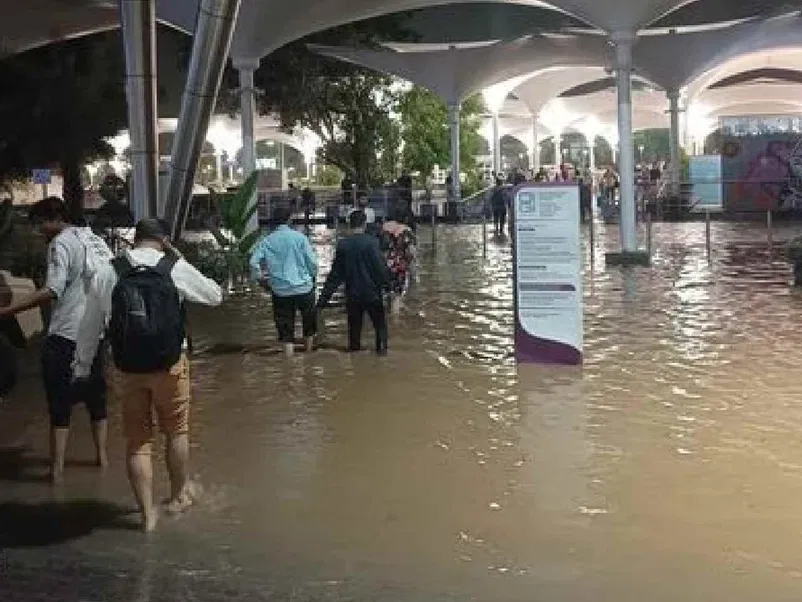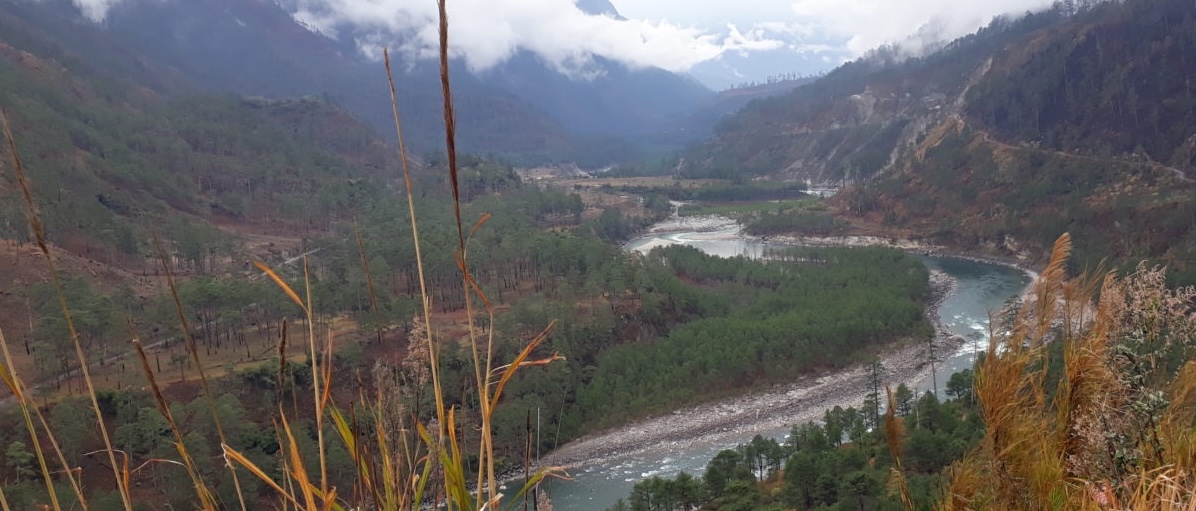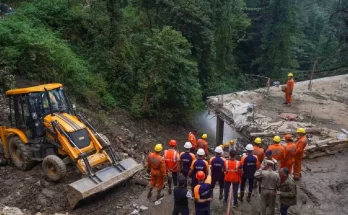CDRI report suggests preventive methods to safeguard existing and proposed airports against extreme weather events.

Sardar Vallabhbhai Patel Airport at Ahmedabad witnessed massive flooding on Sunday. (Photo credit: PTI)
New Delhi: On Sunday, Sardar Vallabhbhai Patel Airport at Ahmedabad witnessed massive flooding after extremely heavy rainfall, leaving passengers in knee-deep waters. As the visuals hit social media, people shared examples from the past when torrential rainfall had caused flooding at other Indian airports. For example, Cochin Airport had witnessed a loss of Rs 220 crore after being submerged for days in August 2018 and the entire roof of Visakhapatnam airport was damaged during Cyclone Hudhud in 2014.
It comes as no surprise then that a recent report found the vulnerability of India’s airports to be quite high. “Indian airports exhibit a higher Airport Exposure Index compared to other participating airports from across the world,” stated the ‘Global Study on Disaster Resilience of Airports’ brought out by the Coalition for Disaster Resilient Infrastructure (CDRI).
In simple terms, Indian airports that participated in the research were found to be more exposed to extreme heat and precipitation than their counterparts, and less exposed to extreme storms and winds.
“About 76% of participating Indian airports have identified their critical assets and adaptive measures against future hazards compared to 67% in the rest of the world. Overall, Indian airports anticipate aircraft, communication systems, and utility systems to be their most impacted assets, although with a lower severity than the rest of the world,” the CDRI report mentioned.
Launched by Prime Minister Narendra Modi at the 2019 UN Climate Change Summit, CDRI is a global multi-stakeholder partnership of national governments, UN agencies, programmes, multilateral development banks financing mechanisms, private sector, academic and knowledge institutions.
The significance of airport resilience
The CDRI survey received responses from 111 airports in 54 countries in the first phase. In the second phase, there were 12 airports from 11 countries. As many as 25 airports from India responded to their survey.
Based on the inputs by the respondents, improving drainage and safeguarding power supply are the primary infrastructure-focused measures that are necessary for developing hazard-specific and infrastructure-specific recovery plans. This is important in view of the fact that airports are not just for passengers but also crucial logistic hubs. Shutting down of an airport disrupts the whole supply chain and the economy overall.
The Intergovernmental Panel on Climate Change (IPCC) Assessment Report (AR6) has also mentioned that India is amongst the most vulnerable countries when it comes to extreme weather events.
The resilience of the transportation sector is an often overlooked aspect, and the fast growth in the aviation sector was one of the reasons why the CDRI went ahead with this survey. “By 2038, global air transport is forecasted to support 143 million jobs and contribute $6.3 trillion to the global economy. Airport infrastructure is seeing rapid development and expansion, with approximately $2.4 trillion of total capital investment expected on global airport infrastructure development up to 2040,” Amit Prothi, Director General, CDRI, told News9 Plus.
Ahmedabad not the only example
Ahmedabad airport’s problem is neither unique nor the first of its kind. Such flooding can also be traced to the absence of proper drainage. “All natural drainage in that city has been destroyed to build highways and other infrastructure projects. There are no water bodies or green spaces to absorb the excess water. No wonder it floods every year,” said NM Prusty, a disaster management professional.
But what happened at Ahmedabad airport is not the only example. And, unfortunately, other examples in the past have seen even worst problems, leading to economic losses too. Extremely heavy rains in Delhi-NCR, Himachal Pradesh, and Uttarakhand this month caused major disruptions at Delhi airport. At least 20 flights were cancelled and more than 110 were delayed.
Flooding of Chennai airport in December 2015, Cochin airport in August 2018, Delhi airport in September 2021, and Bengaluru airport in October 2021 are some other examples.
Prusty suggested elevated corridors in Hyderabad and Bengaluru to ensure access to airports even when there is flooding in large parts of the city.
Two proposed airports, one in Mandi, Himachal Pradesh, and the other in Tamil Nadu’s Chennai, too, have faced similar issues and a lot of opposition from the locals.
Manshi Asher, researcher-activist and co-founder of Himdhara Collective, an advocacy NGO, told News9 Plus, “In case of the proposed Mandi greenfield airport, there are three other civilian airports without a technical impact assessment. The in-principle site clearance was granted in 2018. To date, no technical studies have been carried out. In the absence of a proper technical study, without any clear details about the project and its need, the state government commissioned a Social Impact Assessment (SIA) study.”
The proposed airport is planned in the Balh Valley, floodplain of the Suketi river, a tributary of the Beas. It has fertile land and a commercially thriving economy of vegetable cultivation which will be displaced. “If we look at the SIA report, nearly 40% of the respondents have raised the issue of floods in the region. The consent of the affected gram sabhas under the SIA and the public consultations under the EIA are both critical processes,” Asher stated.
Meanwhile, in case of the proposed second airport for Chennai, which is at Parandur, about 65 km away, environmental activists have alleged that the hydrological balance of the water-scarce Chennai metropolitan region will be threatened by the project. Of the 1,847.60 hectare land identified for the project, almost 990.60 hectare are wetlands, lakes, and ponds, the activists have alleged.
“Identifying wetlands and water bodies, bringing them under legally empowered wetland authorities and then protecting such wetlands will help,” said Prusty.
But airport vulnerability is not just about access or the premises flooding at the airport. “The communication infrastructure, including wireless infrastructure and cell towers, can suffer damage, resulting in signal loss and disruptions. Further, power outages caused by these weather events affect communication systems reliant on electricity, as well as lighting, security systems, baggage handling, passenger information systems, and other operations. Additionally, flooding or heavy rainfall can lead to waterlogging and damage water supply systems, impacting fuel supply and airport operations,” the CDRI DG said.
“Services dependent on water, such as restroom facilities and fire suppression systems, as well as the delivery of fuel to aircraft and ground support equipment, can also be affected. These disruptions can have a domino effect on airport operations, causing potential safety risks,” he added.
What is the way forward?
The CDRI report talks about global scenario, but the highest number of respondent airports were from the Indian subcontinent, 25 of them from India. In the Asia-Pacific region, the leading hazards include extreme precipitation, extreme storms and winds. This is a region that is battered most by tropical monsoon and tropical cyclones or typhoons.
Globally, runways, terminal, and communication systems are given the highest priority among the critical airport assets, the report said, adding, “Multi-hazard platform risk exposure calculation factors in the survey included extreme heat, icing conditions, and precipitation, intensity of storms and winds, landslides and earthquakes, low air quality and flooding at participating airports.”
Fortunately, most (>90%) Indian participating airports indicated having an Airport Emergency Response Plan to continue operations during hazardous events, as well as a Disaster Recovery Plan. However, the report pointed out that only 43% of participating Indian airports conduct Vulnerability Assessments periodically, compared to 63% in the rest of the world.
Regular Vulnerability Assessment study is important to know the level of preparedness, as by every passing year, the nature of hazards and its response owing to local conditions may change.
CDRI has recommended giving priority to the following measures: Firstly, regular inspections and maintenance should be emphasised for essential infrastructure and systems within airports, ensuring the resilience of structural facilities that support both passenger and cargo operations. Secondly, it is crucial to enhance the resilience of transportation modes beyond airports, enabling integrated and seamless movement of passengers and cargo to and from airports.
“Furthermore, understanding the vulnerability and risk levels of airports is of utmost importance, as it allows for informed decision-making regarding investments in resilience interventions. Integrating resilience measures can result in safeguarding both infrastructure and investments,” Prothi added.
(This story first appeared on news9live.com on Jul 24, 2023 and can be read here.)



